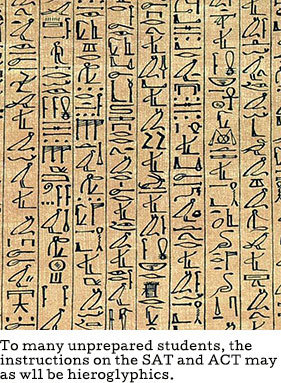
Obviously, the main differences between the SAT and the classroom test is that the SAT is much longer and much more important. In order to understand the more subtle differences between high school assessment and the SAT, we’re going to look at the inherent differences between the classroom and the SAT test room.
The Classroom
-
The test maker: The person who makes your test is the person responsible for teaching and assigning all the material covered in the class. If the teacher is concerned about students listening, he or she might include questions specifically from lectures. Likewise, if the reading is especially challenging, a test might include a question from some of the harder parts that will stump many students. The bottom line, however, is that the teacher is in complete control of the coursework, the classroom, making the test and scoring it.
-
The test length: Most class periods are an hour long, and many students’ attention spans are much shorter. Thus, the high school test tends to be an hour long or less, and this makes it much easier than the SAT.
-
The test content: This is where the high school test differs most greatly from any standardized test. The high school teacher is in total control of both the curriculum and the test, as well as answering students’ questions about gaps between the two after grading. This centralized control allows for any mistakes to be corrected after the test is given, as well as for the material to coincide perfectly with what’s been taught.
The SAT
-
The test maker: The authors of the SAT have the huge job of trying to summarize all necessary college skills and content in a 4-hour test. More limiting, though, is the need for the test to remain as fair and consistent as possible. So while a teacher can just omit questions that weren’t covered in class, the SAT must ask about the exact same skills in every test until it announces a redesign that will give all students a fair chance at mastering the new test.
-
The test length: The SAT is trying to test every aspect of academic college readiness, so it’s a long test. Duh. Even with breaks, sitting at a desk for that long is difficult and stressful for most students. Fortunately, practice can help with this discomfort as well as running out of time on specific sections, but the length remains an obstacle for many on the SAT.
-
The test content: The SAT claims to test a stable set of skills and content that indicate students’ readiness for college academics. This means that the same types of questions show up year after year, testing the same material, regardless of the progress made by individual classes, schools, districts, counties, or even states. If your state’s overall grades and statewide testing scores drop one year, the SAT will be the same. This creates gaps in knowledge for many students, especially at schools in low-income districts, where limited resources make effective learning for every student especially difficult.
The Biggest Difference: Format and Preparation
The content challenge has also led the SAT to a quite odd question format, in an attempt to eliminate any possible technicalities that might make the test unfair. At PrepScholar, our hundreds of hours of examining the test has made clear very specific standards that the SAT always follows to be completely precise and correct every time, from using the word “mostly” and “primarily” a lot to including complex instructions at the start of every section. Thus, while your teacher can explain his or her test questions’ format (and they are unlikely to change over the tests you take in the course), in the SAT you’ve got one chance, and they have to cram all that extra info into the test itself. And if you’ve got questions about it on test day, tough luck.
If you found this article useful, please consider joining our email list at right. Your information will never be shared or sold.











